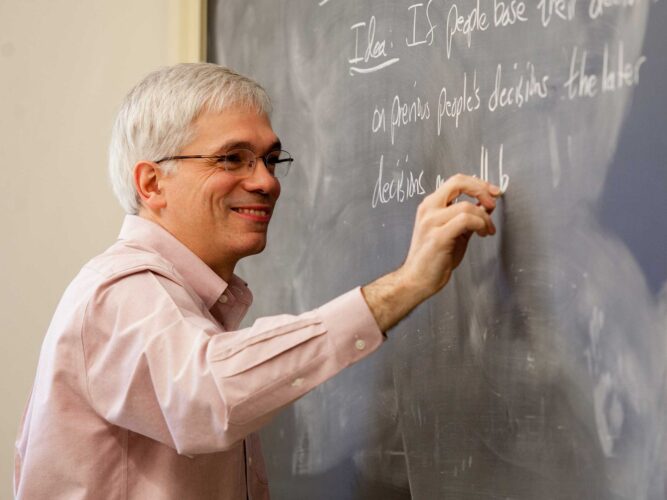If you ask Dan Schult, Colgate University’s Charles G. Hetherington Professor of mathematics, what interests him most, he’ll say dynamics.

“Dynamics means patterns in time,” Schult says.
Schult’s work in dynamics has helped NASA prevent fires on the space station; helped astronomers worldwide assemble the first-ever image of a black hole; and, through the software he co-authored, has helped so many researchers model so many types of dynamic networks that he’s lost count.
Today, Schult has added neuroscience and physics to the roster of topics to which he’s made mathematical contributions. His latest work examines how we might make electronic networks that more directly mirror neurons in the brain. All the while he’s still managing his software package, NetworkX, as well as directing the Picker Interdisciplinary Science Institute at Colgate.
Fires in Space
The Colgate mathematician got his start studying fire, not with physical flames, but with mathematical models that simulate the dynamics of fire spreading along insulation in walls — like in the space station.
“Most of my papers were on zero gravity, because it’s a lot simpler to do the math,” Schult says, “but also because NASA was funding the work. They don’t want fires up in space.”
Imagine, for instance, the way fire burns across a piece of paper. It doesn’t create a big flame. Instead, a black line of char creeps, unevenly, along the page. When one finger of flame starts to get ahead of the rest, it gets better access to oxygen, which allows it to burn faster and travel even farther. “That’s the story,” Schult says. “The math shows you that the story is true.”
“My interest in it was the patterns,” he says. “NASA’s interest was keeping fire from burning things.”
NetworkX
Branching out from his fiery beginnings, Schult expanded from studying spreading flames to spreading over all kinds of networks. He studied the spreading of disease during the 2003 SARS epidemic in China — long before anyone had ever heard of its successor. And in 2005, while working on that SARS project, Schult co-authored a software package called NetworkX that’s still widely used today.
NetworkX is a tool that allows scientists and other computer analysts to model any kind of network using the programming language Python. The basic premise is that any network is made up of many interconnected nodes. Some nodes or some connections might be stronger than others, which causes patterns to form when something spreads across the network over time.
You might simulate a virus spreading over a computer network or a virus spreading over a human network. You might model how proteins work together in a cell, where a single trigger sets off a network of cellular reactions. Or you might help construct the first-ever image of a black hole.
In 2019 astronomers released an image of the black hole in the center of galaxy M87. The image wasn’t a photograph, but a highly processed rendering of many images from the Event Horizon Telescope — itself a network of multiple different telescopes. Assembling the image was no small feat, and it required coordination not only of which images overlapped, but of which parts of which images overlapped. They used NetworkX to help do it.
Building Models

When mathematicians make models, they’re almost always equations and computer simulations. But some of Schult’s most recent work has taken “model” more literally. He’s not on the runway for fashion week, but he is working with physicists to make an analog model that can physically demonstrate ideas about the human brain.
He, along with Ken Segall, professor of physics, and Patrick Crotty, associate professor of physics and astronomy, are studying Josephson junctions. When two superconductors are placed close together, a pulse of voltage oscillates between them — much in the same way neurons pulse to communicate in the brain. Schult and Segall are testing to see if these physical electrical circuits can model behavior in the brain. Eventually, it may be a new way to structure computers doing machine learning — a more literal take on the “neural network.”
“The electronic system we’re working with would be about 100 times faster and consume much less power than the standard neural network models,” Schult says.
Spreading Interdisciplinarity
This year marks Schult’s ninth as director of the Picker Institute, over half of the interdisciplinary institute’s 15-year existence.
The institute funds research for faculty and staff across disciplines and often includes collaborations with researchers outside Colgate. For instance, one project studies whether the genetic differences between early birds and night owls impact performance on mental and physical tests taken at different times of the day — looping in not just biologists, but the writing center and the athletics department. Research on how young birds learn their songs benefits from not just neuroscientists, but child developmental psychologists and learning experts from the education department. Others have studied climate change in the Arctic, invasive North American earthworms, and more.
“The pandemic impacted the Picker Institute in a big way,” Schult says. “I think faculty in general were not able to focus on research, because they were spending so much time making sure the teaching worked, and it was so hard to plan for the future.” Looking forward, he is most anticipating to the Picker Institute bouncing back to its pre-pandemic activity levels.

